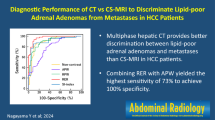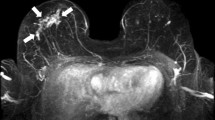Abstract
Purpose
The aim of this study is to determine if contrast enhanced (CE) sampling perfection with application-optimized contrasts using different flip-angle evolutions (SPACE) images can provide clearer pituitary adenoma margin than conventional CE T1-weighted spin echo (T1-SE) sequence for cavernous sinus (CS) invasion evaluation.
Methods
21 healthy volunteers were preformed with SPACE scans before and after administration of gadopentetate dimeglumine at different time points (1, 7 and 13 min). Signal intensity (SI) of regions of interest was plotted in SI/time curves for bilateral CS, pituitary and temporal lobe. 35 patients with pituitary adenoma (≥1 cm) were performed CE T1-SE and CE SPACE scans. Two observers made the visual assessment of the tumor margin delineation and CS invasion evaluation on both SPACE and T1-SE images. Surgical findings were compared with the invasion assessment results.
Results
At 1, 7 and 13 min after enhancement, SI of left CS increased 6.7, 9.5 and 11.2 % respectively compared with unenhanced images (all p < 0.05). Right CS increased 7.2, 9.3 and 11.3 % (all p < 0.05 %). Within pituitary, a decline (6.3 %, p < 0.05) of SI was measured at 1 min after enhancement. CE SPACE performed superior to those of CE T1-SE sequence in visual assessment of tumor edge (assessment score, 1.66 ± 0.42 vs. 1.23 ± 0.65, p < 0.05), as well as the specificity (86.8 vs. 66.0 %, p < 0.05) and accuracy(85.7 vs. 68.6 %, p < 0.05) for CS invasion evaluation.
Conclusion
CE SPACE could provide better contrast of pituitary adenoma with surrounding CS and clear demonstration of tumor edge for CS invasion evaluation than conventional CE T1-SE sequence.





Similar content being viewed by others
References
Tao YX, Qu QY, Wang ZL, Zhang QH (2010) Endoscopic transsphenoidal approach to pituitary adenomas invading the cavernous sinus. Chin Med J (Engl) 123:3519–3523
Cinar N, Tekinel Y, Dagdelen S, Oruckaptan H, Soylemezoglu F, Erbas T (2013) Cavernous sinus invasion might be a risk factor for apoplexy. Pituitary 16(4):483–489
Koutourousiou M, Gardner PA, Fernandez-Miranda JC, Paluzzi A, Wang EW, Snyderman CH (2013) Endoscopic endonasal surgery for giant pituitary adenomas: advantages and limitations. J Neurosurg 118:621–631
Shah S, Waldman AD, Mehta A (2012) Advances in pituitary imaging technology and future prospects. Best Pract Res Clin Endocrinol Metab 26:35–46
Kato Y, Higano S, Tamura H, Mugikura S, Umetsu A, Murata T, Takahashi S (2009) Usefulness of contrast-enhanced T1-weighted sampling perfection with application-optimized contrasts by using different flip angle evolutions in detection of small brain metastasis at 3T MR imaging: comparison with magnetization-prepared rapid acquisition of gradient echo imaging. AJNR Am J Neuroradiol 30:923–929
Tins B, Cassar-Pullicino V, Haddaway M, Nachtrab U (2012) The three-dimensional sampling perfection with application-optimised contrasts using different flip angle evolutions sequence for routine imaging of the spine: preliminary experience. Br J Radiol
Baumert B, Wortler K, Steffinger D, Schmidt GP, Reiser MF, Baur-Melnyk A (2009) Assessment of the internal craniocervical ligaments with a new magnetic resonance imaging sequence: three-dimensional turbo spin echo with variable flip-angle distribution (SPACE). Magn Reson Imaging 27:954–960
Watanabe Y, Makidono A, Nakamura M, Saida Y (2011) 3D MR cisternography to identify distal dural rings: comparison of 3D-CISS and 3D-SPACE sequences. Magn Reson Med Sci 10:29–32
Knosp E, Steiner E, Kitz K, Matula C (1993) Pituitary adenomas with invasion of the cavernous sinus space: a magnetic resonance imaging classification compared with surgical findings. Neurosurgery 33(4):610–618
Cottier JP, Destrieux C, Brunereau L, Bertrand P, Moreau L, Jan M, Herbreteau D (2000) Cavernous sinus invasion by pituitary adenoma: MR imaging. Radiology 215:463–469
Wolfsberger S, Ba-Ssalamah A, Pinker K, Mlynárik V (2004) Application of three-tesla magnetic resonance imaging for diagnosis and surgery of sellar lesions. J Neurosurg 100(2):278–286
Vieira JO, Cukiert A, Liberman B (2006) Evaluation of magnetic resonance imaging criteria for cavernous sinus invasion in patients with pituitary adenomas: logistic regression analysis and correlation with surgical findings. Surg Neurol 65:130–135
Nelson KL, Runge VM (1995) Basic principles of MR contrast. Top Magn Reson Imaging 7(3):124–136
Ceylan S, Anik I, Koc K (2011) A new endoscopic surgical classification and invasion criteria for pituitary adenomas involving the cavernous sinus. Turk Neurosurg 21(3):330–339
Cao L, Chen H, Hong J, Ma M (2013) Magnetic resonance imaging appearance of the medial wall of the cavernous sinus for the assessment of cavernous sinus invasion by pituitary adenomas. J Neuroradiol 40(4):245–251
Acknowledgments
The authors are grateful to Professor Hanqiu Liu and Professor Junhai Zhang for making assessments. We have no financial disclosure to claim for each author.
Conflict of interest
The authors declare that they have no conflict of interest.
Author information
Authors and Affiliations
Corresponding author
Rights and permissions
About this article
Cite this article
Wu, Y., Wang, J., Yao, Z. et al. Effective performance of contrast enhanced SPACE imaging in clearly depicting the margin of pituitary adenoma. Pituitary 18, 480–486 (2015). https://doi.org/10.1007/s11102-014-0599-0
Published:
Issue Date:
DOI: https://doi.org/10.1007/s11102-014-0599-0




